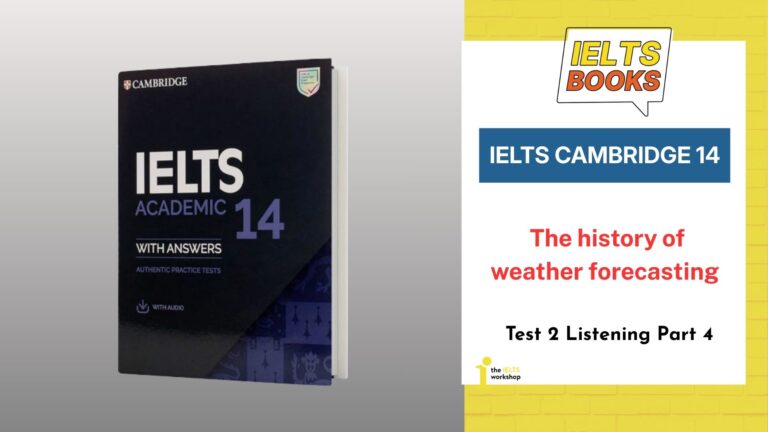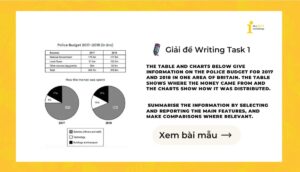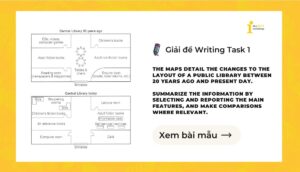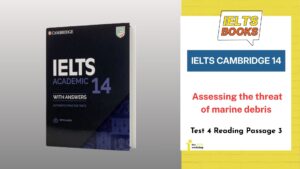Cambridge từng là cuốn sách gây ám ảnh với nhiều sĩ tử IELTS bởi độ khó và tính sát đề thi thật của nó. Vậy làm thế nào để luyện tập hiệu quả? Bài viết này The IELTS Workshop cung cấp đáp án, transcript, bản dịch và hướng dẫn giải chi tiết IELTS Cambridge 14 Test 2 Listening Part 4: The history of weather forecasting giúp bạn nâng cao kĩ năng và khả năng sử dụng tiếng anh của mình.
Đáp án IELTS Cambridge 14 Test 2 Listening Part 4
| Question | Đáp án |
| 31 | dances |
| 32 | survival |
| 33 | clouds |
| 34 | festivals |
| 35 | comets |
| 36 | sky |
| 37 | instruments |
| 38 | thermometer |
| 39 | storms |
| 40 | telegraph |
Transcript và bản dịch chi tiết IELTS Cambridge 14 Test 2 Listening Part 4
| Transcipt | Bản dịch |
| In this series of lectures about the history of weather forecasting, I’ll start by examining its early history – that’ll be the subject of today’s talk.Ok, so we’ll start by going back thousands of years. Most ancient cultures had weather gods, and weather catastrophes, such as floods, played an important role in many creation myths. Generally, weather was attributed to the whims of the gods, as the wide range of weather gods in various cultures shows. For instance, there’s the Egyptian sun god Ra, and Thor, the Norse god of thunder and lightning. Many ancient civilisations developed rites such as (Q31) dances in order to make the weather gods look kindly on them. | Trong chuỗi bài giảng về lịch sử dự báo thời tiết này, tôi sẽ bắt đầu bằng cách tìm hiểu lịch sử ban đầu của nó – đó sẽ là chủ đề của bài nói hôm nay.Được rồi, vậy chúng ta sẽ bắt đầu bằng cách quay trở lại hàng ngàn năm trước. Hầu hết các nền văn hóa cổ đại đều có các vị thần thời tiết, và những thảm họa thời tiết, chẳng hạn như lũ lụt, đóng vai trò quan trọng trong nhiều thần thoại sáng thế. Nhìn chung, thời tiết được cho là do ý muốn thất thường của các vị thần, như được thể hiện qua sự đa dạng của các vị thần thời tiết trong nhiều nền văn hóa khác nhau. Ví dụ, có vị thần mặt trời của Ai Cập là Ra, và Thor – vị thần sấm sét và tia chớp trong thần thoại Bắc Âu. Nhiều nền văn minh cổ đại đã phát triển các nghi lễ như (Q31) những điệu nhảy để làm các vị thần thời tiết vui lòng. |
| But the weather was of daily importance: observing the skies and drawing the correct conclusions from these observations was really important, in fact their (Q32) survival depended on it. It isn’t known when people first started to observe the skies, but at around 650 BC, the Babylonians produced the first short-range weather forecasts, based on their observations of (Q33) clouds and other phenomena. The Chinese also recognised weather patterns, and by 300 BC, astronomers had developed a calendar which divided the year into 24 (Q34) festivals, each associated with a different weather phenomenon. | Tuy nhiên, thời tiết lại có tầm quan trọng hằng ngày: việc quan sát bầu trời và rút ra kết luận đúng từ những quan sát đó là điều vô cùng quan trọng, thực tế là (Q32) sự sống còn của họ phụ thuộc vào điều đó. Người ta không biết chính xác thời điểm con người bắt đầu quan sát bầu trời là khi nào, nhưng khoảng năm 650 trước Công nguyên, người Babylon đã đưa ra những dự báo thời tiết ngắn hạn đầu tiên, dựa trên việc quan sát (Q33) mây và các hiện tượng khác. Người Trung Quốc cũng nhận biết được các kiểu thời tiết, và vào khoảng năm 300 trước Công nguyên, các nhà thiên văn học đã phát triển một loại lịch chia năm thành 24 (Q34) tiết khí, mỗi tiết khí gắn với một hiện tượng thời tiết khác nhau. |
| The ancient Greeks were the first to develop a more scientific approach to explaining the weather. The work of the philosopher and scientist Aristotle, in the fourth century BC, is especially noteworthy, as his ideas held sway for nearly 2,000 years. In 340 BC, he wrote a book in which he attempted to account for the formation of rain, clouds, wind and storms. He also described celestial phenomena such as haloes – that is, bright circles of light around the sun, the moon and bright stars – and (Q35) comets. Many of his observations were surprisingly accurate. For example, he believed that heat could cause water to evaporate. But he also jumped to quite a few wrong conclusions, such as that winds are breathed out by the Earth. Errors like this were rectified from the Renaissance onwards. | Người Hy Lạp cổ đại là những người đầu tiên phát triển một cách tiếp cận mang tính khoa học hơn để giải thích thời tiết. Tác phẩm của nhà triết học và khoa học Aristotle vào thế kỷ IV trước Công nguyên đặc biệt đáng chú ý, vì những ý tưởng của ông đã thống trị suốt gần 2.000 năm. Vào năm 340 trước Công nguyên, ông đã viết một cuốn sách trong đó ông cố gắng lý giải sự hình thành của mưa, mây, gió và bão. Ông cũng mô tả các hiện tượng thiên văn như quầng sáng – tức là vòng tròn sáng quanh mặt trời, mặt trăng và các ngôi sao sáng – và cả (Q35) sao chổi. Nhiều quan sát của ông đáng ngạc nhiên là khá chính xác. Ví dụ, ông tin rằng nhiệt có thể khiến nước bốc hơi. Tuy nhiên, ông cũng đưa ra khá nhiều kết luận sai, như cho rằng gió là do Trái đất thở ra. Những sai lầm như vậy chỉ được sửa lại từ thời Phục hưng trở đi. |
| For nearly 2,000 years, Aristotle’s work was accepted as the chief authority on weather theory. Alongside this, though, in the Middle Ages weather observations were passed on in the form of proverbs, such as ‘Red (Q36) sky at night, shepherd’s delight; red sky in the morning, shepherd’s warning’. Many of these are based on very good observations and are accurate, as contemporary meteorologists have discovered. | Suốt gần 2.000 năm, công trình của Aristotle được xem là nền tảng chính của lý thuyết thời tiết. Tuy nhiên, song song với điều đó, trong thời Trung cổ, các quan sát về thời tiết được truyền miệng qua các câu tục ngữ, ví dụ như: “(Q36) Trời đỏ lúc hoàng hôn thì người chăn cừu vui mừng; trời đỏ lúc bình minh thì người chăn cừu cảnh giác”. Nhiều câu trong số này dựa trên các quan sát rất chính xác, và các nhà khí tượng học hiện đại đã phát hiện rằng chúng thực sự có cơ sở. |
| For centuries, any attempt to forecast the weather could only be based on personal observation, but in the fifteenth century scientists began to see the need for (Q37) instruments. Until then, the only ones available were weather vanes – to determine the wind direction – and early versions of rain gauges. One of the first, invented in the fifteenth century, was a hygrometer, which measured humidity. This was one of many inventions that contributed to the development of weather forecasting. | Trong nhiều thế kỷ, bất kỳ nỗ lực nào nhằm dự báo thời tiết chỉ có thể dựa trên quan sát cá nhân, nhưng vào thế kỷ XV, các nhà khoa học bắt đầu nhận ra sự cần thiết của (Q37) các công cụ đo đạc. Trước đó, các thiết bị duy nhất có sẵn là chong chóng gió – để xác định hướng gió – và các phiên bản thô sơ của đồng hồ đo mưa. Một trong những thiết bị đầu tiên được phát minh vào thế kỷ XV là ẩm kế (hygrometer), dùng để đo độ ẩm. Đây là một trong nhiều phát minh đã góp phần vào sự phát triển của dự báo thời tiết. |
| In 1592, the Italian scientist and inventor Galileo developed the world’s first (Q38) thermometer. His student Torricelli later invented the barometer, which allowed people to measure atmospheric pressure. In 1648, the French philosopher Pascal proved that pressure decreases with altitude. This discovery was verified by English astronomer Halley in 1686, and Halley was also the first person to map trade winds. | Năm 1592, nhà khoa học kiêm nhà phát minh người Ý – Galileo – đã phát triển (Q38) nhiệt kế đầu tiên trên thế giới. Học trò của ông, Torricelli, sau đó phát minh ra khí áp kế (barometer), giúp con người đo áp suất khí quyển. Đến năm 1648, nhà triết học người Pháp – Pascal – đã chứng minh rằng áp suất giảm theo độ cao. Phát hiện này được xác nhận lại bởi nhà thiên văn học người Anh – Halley – vào năm 1686, và chính Halley cũng là người đầu tiên vẽ bản đồ các luồng gió mậu dịch. |
| This increasing ability to measure factors related to weather helped scientists to understand the atmosphere and its processes better, and they started collecting weather observation data systematically. In the eighteenth century, the scientist and politician Benjamin Franklin carried out work on electricity and lightning in particular, but he was also very interested in weather and studied it throughout most of his life. It was Franklin who discovered that (Q39) storms generally travel from west to east. | Khả năng ngày càng tăng trong việc đo lường các yếu tố liên quan đến thời tiết đã giúp các nhà khoa học hiểu rõ hơn về bầu khí quyển và các quá trình bên trong nó, và họ bắt đầu thu thập dữ liệu thời tiết một cách hệ thống. Vào thế kỷ XVIII, nhà khoa học kiêm chính trị gia Benjamin Franklin đã tiến hành nghiên cứu về điện và đặc biệt là sét, nhưng ông cũng rất quan tâm đến thời tiết và đã nghiên cứu nó trong phần lớn cuộc đời. Chính Franklin đã khám phá ra rằng (Q39) các cơn bão thường di chuyển từ tây sang đông. |
| In addition to new meteorological instruments, other developments contributed to our understanding of the atmosphere. People in different locations began to keep records, and in the mid-nineteenth century, the invention of the (Q40) telegraph made it possible for these records to be collated. This led, by the end of the nineteenth century, to the first weather services.It was not until the early twentieth century that mathematics and physics became part of meteorology, and we’ll continue from that point next week. | Bên cạnh các công cụ khí tượng mới, những tiến bộ khác cũng góp phần vào việc hiểu biết bầu khí quyển. Người dân ở nhiều khu vực bắt đầu lưu giữ hồ sơ thời tiết, và vào giữa thế kỷ XIX, sự ra đời của (Q40) điện báo đã khiến việc tổng hợp các hồ sơ này trở nên khả thi. Điều này dẫn đến sự ra đời của các dịch vụ thời tiết đầu tiên vào cuối thế kỷ XIX.Phải đến đầu thế kỷ XX thì toán học và vật lý mới bắt đầu trở thành một phần của khí tượng học, và chúng ta sẽ tiếp tục từ điểm đó vào tuần sau. |
Phân tích chi tiết IELTS Cambridge 14 Test 2 Listening Part 4
Câu 31 – Đáp án: dances
Tiếng Anh: many cultures invented ………………… and other ceremonies to make the weather gods friendly
Dịch câu hỏi: nhiều nền văn hóa đã phát minh ra ………………… và các nghi lễ khác để làm cho các vị thần thời tiết trở nên thân thiện
Transcript: “many ancient civilisations developed rites… such as dances.”
Phân tích: Người nói đề cập “many ancient civilisations developed rites… such as dances.” Từ “dances” khớp trực tiếp với ô trống.
Gợi ý trong bài: cultures = ancient civilisations, invented = developed, ceremonies = rites
Câu 32 – Đáp án: survival
Tiếng Anh: people needed to observe and interpret the sky to ensure their ………………….
Dịch câu hỏi: mọi người cần quan sát và giải thích bầu trời để đảm bảo ………………….
Transcript: “But the weather was of daily importance: observing the skies and drawing the correct conclusions from these observations was really important, in fact their survival depended on it.”
Phân tích: Người nói chỉ ra rằng “their survival depended on it [drawing correct conclusions from observations]”. Từ “survival” khớp với ngữ cảnh về sự phụ thuộc.
Gợi ý trong bài: needed to = was really important, interpret the sky = drawing the correct conclusions from these observations, ensure = depended on it
Câu 33 – Đáp án: clouds
Tiếng Anh: around 650 BC, Babylonians started forecasting, using weather phenomena such as ………………….
Dịch câu hỏi: Khoảng năm 650 trước Công nguyên, người Babylon bắt đầu dự báo thời tiết bằng cách sử dụng các hiện tượng thời tiết như ………………….
Transcript: “Around 650 BC, the Babylonians… based on their observations of clouds and other phenomena.”
Phân tích: Đoạn transcript nói rõ rằng người Babylon dựa vào quan sát “clouds” để dự báo.
Gợi ý trong bài: Around 650 BC, phenomena
Câu 34 – Đáp án: festivals
Tiếng Anh: by 300 BC, the Chinese had a calendar made up of a number of …………………. connected with the weather
Dịch câu hỏi: đến năm 300 trước Công nguyên, người Trung Quốc đã có một cuốn lịch bao gồm …………………. liên quan đến thời tiết
Transcript: “By 300 BC, the Chinese… developed a calendar which divided the year into 24 festivals, each associated with a different weather phenomenon.”
Phân tích: Transcript trực tiếp đề cập “divided the year into 24 festivals“.
Gợi ý trong bài: By 300 BC, had a calendar = developed a calendar, a number of = 24, connected with = associated with
Câu 35 – Đáp án: comets
Tiếng Anh: Aristotle also described haloes and …………………..
Dịch câu hỏi: Aristotle cũng mô tả quầng sáng và …………………..
Transcript: “the ancient Greeks… Aristotle… also described celestial phenomena such as haloes… and comets.”
Phân tích: Transcript liệt kê “haloes” và “comets” là các hiện tượng thiên thể được Aristotle mô tả.
Gợi ý trong bài: Aristotle, haloes and
Câu 36 – Đáp án: sky
Tiếng Anh: many proverbs, e.g. about the significance of the colour of the …………………., passed on accurate information.
Dịch câu hỏi: nhiều câu tục ngữ, ví dụ như về ý nghĩa của màu sắc của …………………., đã truyền tải thông tin chính xác.
Transcript: “weather observations were passed on in the form of proverbs, such as ‘Red sky at night, shepherd’s delight; red sky in the morning, shepherd’s warning’.”
Phân tích: Phần tục ngữ được trích dẫn trực tiếp có cụm từ “Red sky“, do đó “sky” là từ còn thiếu.
Gợi ý trong bài: proverbs, color
Câu 37 – Đáp án: instruments
Tiếng Anh: Scientists recognised the value of …
Dịch câu hỏi: Các nhà khoa học công nhận giá trị của …
Transcript: “in the fifteenth century scientists began to see the need for instruments.”
Phân tích: Cụm từ “see the need for” đồng nghĩa với “recognised the value of”, và từ còn thiếu là “instruments”.
Gợi ý trong bài: see the need for = recognised the value of
Câu 38 – Đáp án: thermometer
Tiếng Anh: Galileo invented the….
Dịch câu hỏi: Galileo phát minh ra…
Transcript: “Galileo developed the world’s first thermometer.”
Phân tích: Transcript nói rõ “Galileo developed the world’s first thermometer“. “Developed” ở đây có nghĩa tương đương “invented”.
Gợi ý trong bài: Developed = invented
Câu 39 – Đáp án: storms
Tiếng Anh: In the 18th century, Benjamin Franklin identified the movement of…
Dịch câu hỏi: Vào thế kỷ 18, Benjamin Franklin đã xác định sự di chuyển của…
Transcript: “It was Franklin who discovered that storms generally travel from west to east.”
Phân tích: Transcript nói “It was Franklin who discovered that storms generally travel from west to east.” “Discovered” đồng nghĩa với “identified”, và “travel” thể hiện “movement”. Từ còn thiếu là “storms”.
Gợi ý trong bài: Discovered = identified, travel = movement
Câu 40 – Đáp án: telegraph
Tiếng Anh: 19th century: data from different locations could be sent to the same place by …………………
Dịch câu hỏi: Thế kỷ 19: dữ liệu từ nhiều địa điểm khác nhau có thể được gửi đến cùng một nơi bằng cách…
Transcript: “the invention of the telegraph made it possible for these records to be collated.”
Phân tích: Transcript nói rằng “the invention of the telegraph made it possible for these records to be collated.” Việc “collate” (đối chiếu/tổng hợp) các bản ghi từ nhiều nơi khác nhau chính là việc “collect weather observations from different locations”. Từ còn thiếu là “telegraph”.
Gợi ý trong bài: collate = collect weather observations from different locations
Series giải đề IELTS Cambridge 14
- [PDF+Audio] Sách IELTS Cambridge 14 (bản đẹp)
- Giải chi tiết Cambridge 14 Test 2 Listening Part 1: Crime Report Form
- Giải chi tiết Cambridge 14 Test 2 Listening Part 2: Visit to Branley Castle
- Giải chi tiết Cambridge 14 Test 2 Listening Part 3: Woolly mammoths on St Paul’s Island
- Giải chi tiết Cambridge 14 Test 2 Reading Passage 1: Alexander Henderson (1831-1913)
- Giải chi tiết Cambridge 14 Test 2 Reading Passage 2:Back to the future of skyscraper design
- Giải chi tiết Cambridge 14 Test 2 Reading Passage 3: Why companies should welcome disorder
- Đáp án Cambridge 20 & Lời giải chi tiết: Test 1 đến Test 4
Nếu bạn đang tìm kiếm một lộ trình học bài bản, phương pháp rõ ràng và sự đồng hành từ những giáo viên giàu kinh nghiệm, The IELTS Workshop chính là nơi bạn có thể tin tưởng.
Khám phá khóa học IELTS miễn phí tại Website The IELTS Workshop để được trải nghiệm phương pháp học hiện đại, lộ trình cá nhân hóa cùng đội ngũ giáo viên chuyên môn cao ngay nhé!



![[PDF + Audio] Trọn bộ Cambridge Practice Tests For IELTS 1 – 20 mới nhất](https://onthiielts.com.vn/wp-content/uploads/2020/04/cam-1-14-764x400.jpg)
![[PDF + Audio] Cambridge IELTS 20: Cập nhật mới nhất (Bản đẹp)](https://onthiielts.com.vn/wp-content/uploads/2025/07/Cambridge-IELTS-20-300x169.jpg)




